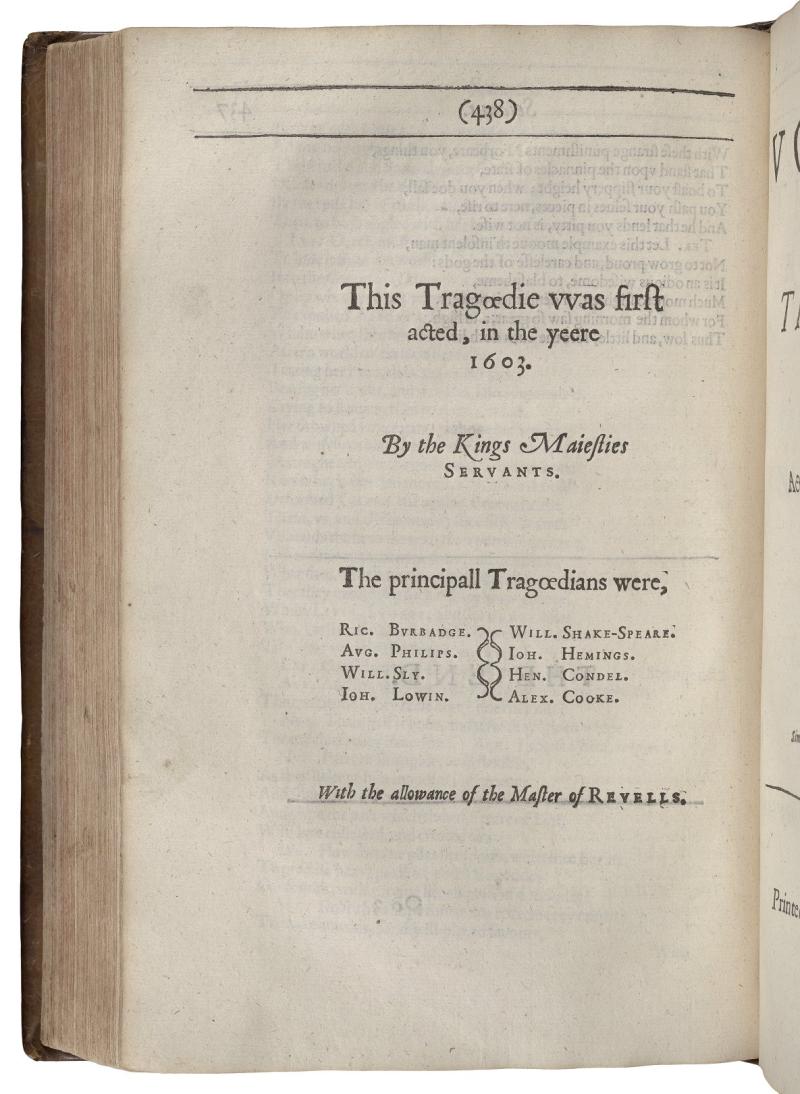Terms of use
Images that are under Folger copyright are licensed under a Creative Commons Attribution-ShareAlike 4.0 International License. This allows you to use our images without additional permission provided that you cite the Folger Shakespeare Library as the source and you license anything you create using the images under the same or equivalent license. For more information, including permissions beyond the scope of this license, see Permissions. The Folger waives permission fees for non-commercial publication by registered non-profits, including university presses, regardless of the license they use. For images copyrighted by an entity other than the Folger, please contact the copyright holder for permission information.
Copy-specific information
Creator: Ben Jonson
Title: The workes of Beniamin Ionson.
Date: Imprinted at London : By Will Stansby, ano. D. 1616.
Repository: Folger Shakespeare Library, Washington, DC, USA
Call number and opening: STC 14751 copy 2, title page, pp. 72 & 438
View online bibliographic record
Alan H. Nelson, "The Works of Benjamin Jonson: Shakespeare included in two cast lists," Shakespeare Documented, https://doi.org/10.37078/257.
Folger Shakespeare Library, STC 14751 copy 2. See Shakespeare Documented, https://doi.org/10.37078/257.
The Shakespeare First Folio (1623) contains a list of “The Names of the Principall Actors in all these Playes.” At the head of the list appears the name of William Shakespeare. Shakespeare’s name occurs in two earlier cast lists, both printed in the Ben Jonson First Folio of 1616, as shown here. Jonson, a far more active self-promoter than Shakespeare, published his own Workes, entered in the Stationers Register on January 20, some three months before Shakespeare’s death in April 1616. Jonson’s publication includes nine plays, with a cast list for each play, along with poems and masques.
More informative than the single list in the Shakespeare First Folio, Jonson’s cast lists not only associate actors with particular plays, but supply the year of the first performance of each play, and identify the playing company. Unfortunately, actors’ names are not associated with particular roles, as in modern playbills, leaving theater historians to speculate on who played what part.
In the two lists presented below, names are expanded and fonts are simplified; for the original forms, photographs should be consulted.
The first cast list is for Every Man In his Humor (p. 72):
This Comoedie was first Acted, in the yeere 1598.
By the then L. Chamberlayne his Servants.
The principall Comœdians were.
William Shakespeare Richard Burbage
Augustine Philips John Hemings
Henry Condell Thomas Pope
William Slye Christopher Beeston
William Kempe John Duke
With the allowance of the Master of Revells.
All actors except Christopher Beeston and John Duke recur in the Shakespeare First Folio. Beeston is named as a fellow of the first rank in Augustine Phillips’s will of May 1605, and Duke is known from other theatrical sources.
The second cast-list containing Shakespeare’s name is for Jonson’s Sejanus (p. 438):
This Tragœdie was first acted, in the yeere 1603.
By the Kings Maiesties Servants.
The principall Tragœdians were,
Richard Burbage William Shake-Speare
Augustine Philips John Hemings
William Sly Henry Condell
John Lowin Alexander Cooke
With the allowance of the Master of Revells.
All eight names recur in the Shakespeare First Folio.
The seven plays for which Shakespeare’s name does not appear are Every Man Out of his Humor (1599); Cynthias Revels (1600); Poetaster (1601); Volpone, or The Fox (1605); Epicene (1609); The Alchemist (1610); and Catiline his Conspiracy (1611). Three of these plays – Cynthias Revels, Poetaster, and Epicene – were performed by child actors. Thus Shakespeare’s name is notably “missing” only from Every Man Out (1599), Volpone (1605), Alchemist (1610), and Catiline (1611).
It is fair to conclude from the Exchequer Declared Accounts of 1595 and from these two Ben Jonson cast lists that William Shakespeare was engaged as a player from the 1590s until at least the second half of 1603 (“the Kings Maiesties Servants” did not receive their patent until May 18 of that year). The absence of his name from later cast lists may be taken as evidence that Shakespeare ended his career as a player before the first performance of Volpone in 1605, presumably so that he could concentrate on his work as a playwright.
The two occurrences of William Shakespeare’s name in Jonson’s 1616 Workes are interesting in other ways also. The forename is given as “Will” in the first list, as “William” in the second (see above photos of page 72 and 438 respectively). The absence of a period (or full-stop) after “Will” – unlike all other abbreviated forenames, including “Will. Slye” and “Will. Kempe,” might be taken as evidence that Shakespeare was sometimes called Will, sometimes William. But the lack of punctuation might equally be a printer’s oversight, or a compositor’s fix for an awkwardly long surname. As to the surname, “Shakespeare” in the 1598 list becomes “Shake-Speare” in the 1603 list. As there is no question that the actor was the same individual in each case, the hyphenation is revealed as no more than an orthographic variant.
The order of names may or may not be significant. In the 1598 cast list, Shakespeare’s is the first name in the first column. Is he given pride of place because he was the leading member of the company, because he took on the lead role, or for no particular reason? In the 1603 cast list his name occurs at the top of the second column. Is this also a position of note, is Shakespeare here playing second fiddle to Richard Burbage, or is his change in position without significance? The Jonson cast lists confirm that Shakespeare was a prominent and active member of his playing company in 1598 and 1603. In other respects, the cast lists raise questions without supplying concrete answers.
Written by Alan H. Nelson
Sources
Samuel Schoenbaum, William Shakespeare: A Documentary Life (1975): 150.
Last updated January 25, 2020












